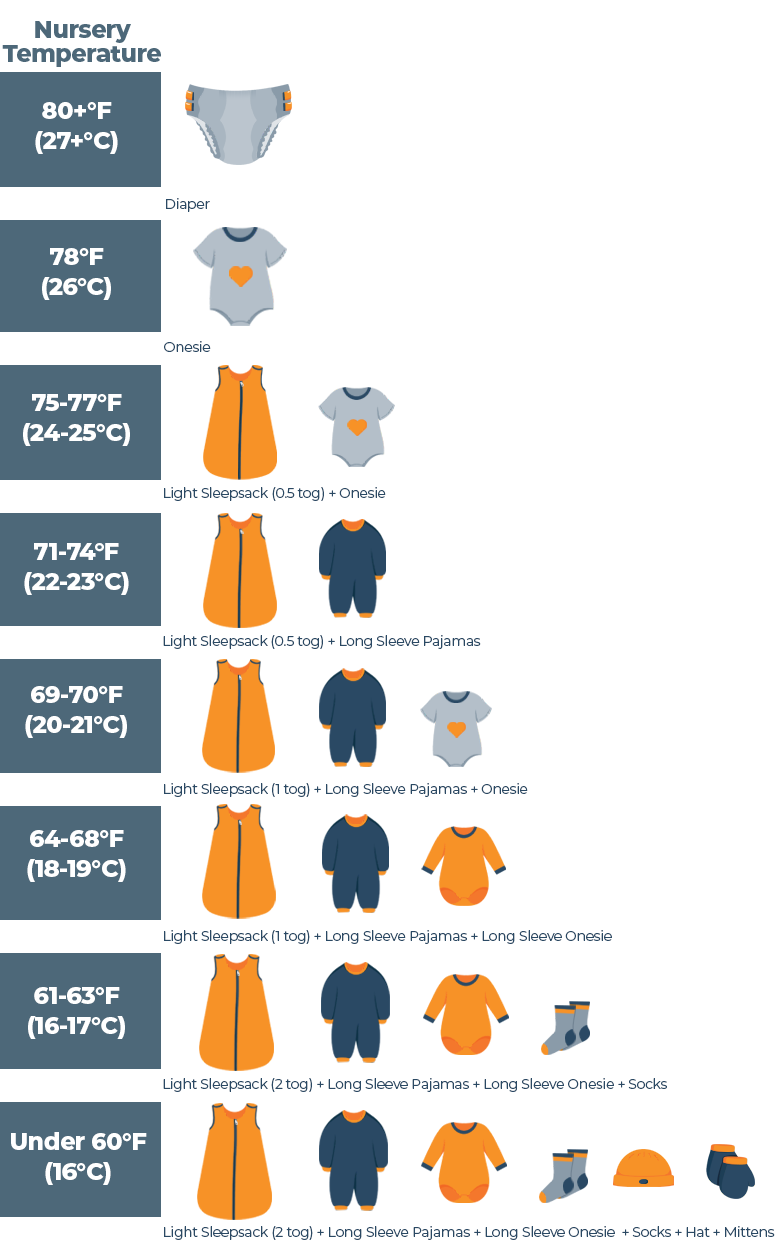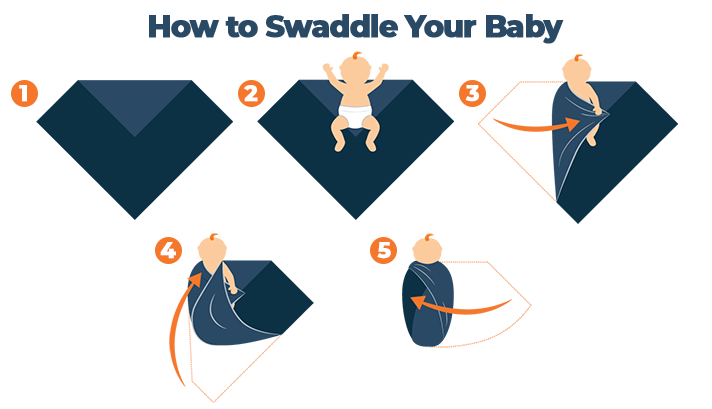Bringing a baby home is an exciting time; however, there are inevitable questions to ask as well as helpful tips to learn. One of these is knowing how to dress your little one for sleep, and being that infants are tiny, you may feel unsure about what’s appropriate.
Naturally, you don’t want your child to be too hot or too cold, and knowing just the right temperature or number of layers can be tough. That’s why we’ve broken it down here to help make your transition as smooth as possible and allow you to feel prepared and ready for your baby’s bedtime.
How to Dress a Baby for Sleep
There are a few basic questions and guidelines to help you dress your baby for sleep. Below we’ll go over what all these entail.
What is the Best Room Temperature for Your Baby?
While you may want your infant to feel cozy and warm, keeping a room too warm can increase the risk of Sudden Infant Death Syndrome (SIDS)1. So how hot is too hot, and how cold is too cold?
Some experts recommend a room temperature between 68 and 72 degrees Fahrenheit2. Keep in mind that this is just an average; every baby is different and may be comfortable at a colder or warmer temperature. A good rule of thumb is to check your baby’s chest. If they are warm but not hot, they’re likely sleeping at the correct temperature. Their extremities, fingers, and toes, can be cool to the touch but not frigid like icicles.
If your baby is born pre-term, it’s a good idea to keep the temperature on the warmer end of this spectrum, as pre-term infants aren’t able to regulate their temperatures as efficiently, according to the Children’s Hospital of Philadelphia3.
Get More Info: The Ideal Room Temperature for a Baby
Checking The Baby’s Temperature
When checking on your baby’s body temperature, you’ll want it to be between 98.6 and 100.3 degrees Fahrenheit4. A temperature that’s above 100.4 is technically considered to be a fever5. You can feel if your child is running hot by gently pressing the back of your hand to their tummy.
Underarm and oral readings for an infant are typically about a full degree cooler than their actual temperature, so it’s best to obtain a reading rectally6 so you can ensure your reading is accurate.
Should Newborns Sleep Under a Blanket?
Blankets are not safe for newborn babies, as they increase the risk of SIDS7. Instead, it’s wise to use a swaddle or sleep sack until your baby is at least one year old. Although sleep sacks can be used for several years, after your baby is one year old, we recommend a lightweight, breathable blanket if you choose to introduce one.
Learn More: Sleep Sack or Swaddle Blanket
Is Your Baby is Comfortable?
If your baby is uncomfortable at night8, you’ll likely know because they’ll be crying, or they won’t be able to fall asleep. While your baby won’t tell you if they’re too hot, too cold, hungry, or need their diaper changed, you can use their crying as a signal to change something up. After all, parenting a baby consists of lots of trial and error.
Learn More: Best Baby Crib Mattress
Baby Sleepwear Based on the Room Temperature
Knowing the appropriate clothing for your baby based on the temperature of their room can feel tricky, which is why we’ve drawn up a chart for easy reference. Have a look below when you’re concerned about sleepwear and room temperature so your baby can be dressed appropriately.
Baby Sleeping Clothes Tips
Naturally, as a parent, you don’t want your infant running too hot or too cold, but figuring out how to make them feel comfortable in their bedroom isn’t easy. We’ll detail how to make sure your baby is ready for anything.
Summer vs. Winter Baby Clothing (TOG)
“TOG”, or Thermal Overall Grade9, is a quality of many products that vary in temperature, such as duvet covers and sleep sacks. In the context of a baby, TOG lets you know about how many blankets a sleep sack is equivalent to. Knowing how warm or cool a sleep sack is will be crucial when dressing your little one so they’re comfortable, without being too hot or cold.
Don’t Use Hats and Beanies At Night
While pulling a warm hat over your baby’s head sounds like a wise idea if it’s cold outside, using a hat could actually be harmful for your baby. A hat may cause your baby to overheat, and it could increase the risk of SIDS10 by covering the baby’s face and potentially causing suffocation.
Swaddling Your Baby for Sleep
Swaddling may sound like a nicer version of a straight jacket for infants, but for them, the sensation of being wrapped up like a burrito is comforting11. Your little one has been snuggled up inside a warm belly for nine months without much wiggle room, so being swaddled tightly mimics the sensation of being held securely.
The feeling of being bundled up helps your newborn to relax and feel secure in their surroundings, and it can help minimize the effects of the Moro reflex12, which is when their little arms suddenly jerk up while asleep. A swaddle should hopefully help them sleep more soundly without disruptions
Finally, a swaddle is a much safer alternative to using a blanket in order to keep your baby warm.
Swaddling a baby takes practice, and over time, it should become easier. As you can see in the graphic above, here are the five steps to follow when swaddling a baby11:
- Spread your swaddle out and fold over the top corner.
- Place your baby on top of the swaddle, face up. Make sure the baby’s head is over the folded top corner.
- Take the left half of the swaddle and wrap it over your baby, tucking it under the baby’s right side.
- Next, grab the bottom corner of the swaddle, and pull it over your baby’s feet towards their head.
- Finally, take the right half of the swaddle and wrap it over your baby, tucking it under the baby’s left side. Now your little one should be cuddled up in their swaddle, ready for bed!
Read More: Best Swaddle Blankets
Using Sleep Sacks
Sleep sacks, which are wearable blankets13 that don’t restrict your baby’s arms, are a great alternative to swaddling once your child has become mobile. If your little one has reached the point where they can now roll over and is not experiencing the Moro reflex any longer, you may want to start using a sleep sack for them.
Sleep sacks allow you to bundle up your baby safely and prepare them to sleep with a blanket, without making a big jump all at once. Babies can still feel safe and secure in their sack but with their arms free. Once babies can roll from front to back, it is important that their arms are free12; if a baby becomes stuck on their stomach without being able to use their arms to flip over to their back, they could suffocate face-down in the mattress. In addition, your baby may find it easier to self-soothe which helps them stay asleep longer.
The sleep sack also should stay securely wrapped around their body in a way that won’t shift so your baby doesn’t get tied up in a compromising position as they could in a loose blanket.
Baby Sleep Safety Tips
Fortunately, there are many family sleep resources to help in your parenthood journey. However, when thinking about how to keep your tyke safe while sleeping, keep it simple.
You don’t want to have too many unnecessary objects or bedding items in the crib, as these can serve as choking or suffocation hazards.
Additionally, keep toys out of the crib during the night14. Not only do you want to teach your baby to fall asleep unaided if possible, but they could suffocate or choke on something in the night as they sleep. It’s wise to keep their crib limited to only a firm mattress and crib sheet.
Want to know more? Check out our safe sleep practices for babies here.
How to Dress a Baby for Sleep FAQs
What should a baby wear in bed when they have a fever?
You may be inclined to bundle your baby up if they have a fever and the chills, but this could make their fever worse. It’s best to dress a child with a fever in lightweight, breathable clothing15. Cotton is great, and a light sleep sack or swaddle is suggested14.
If your child has a high fever, it’s always wise to exercise caution and consult a pediatrician if and when necessary. However, if the fever isn’t terribly high, most children will begin to feel better even after it drops only one degree15.
When should I dress my baby in fleece pajamas?
We don’t recommend dressing your baby in fleece pajamas unless it’s extremely cold outside. You will probably swaddle your baby while they are still young, and fleece pajamas under a swaddle will likely be too hot for your child.
Excess heat can increase the risk of SIDS16, and it’s wise to err on the side of caution. If you’re not sure if your baby is too warm or cold17, place your hand on their neck, tummy, or chest to check if they feel too warm. Also, their cheeks might be flushed if they’re feeling a bit toasty.
Should I dress my baby in one more layer than I am wearing?
The general rule of thumb when dressing a baby18 is that your baby should always be wearing one more layer than you, as their parent, are wearing. If you’re comfortable in short sleeve pajamas, your baby likely will be most comfortable in a long sleeve sleeper.
Conclusion
Knowing how to dress your baby for sleep, when to adjust their layers, how many to put on, when to take them off, what type of material to buy—it can feel overwhelming for any caregiver. Sorting out the details can feel tricky, but you’re not alone.
Keep in mind what we’ve covered in this article, and you’ll be good to go. Maintaining a comfortable room, dressing them appropriately for the season, and swaddling using the correct techniques are all ways to assure that your little snoozer will be sleeping like a baby in no time.
More Reading:
- How To Dress Your Baby For Sleeping In 70 Degree Room?
- When Can You Stop Swaddling Your Baby
- When Can You Stop Using Sleep Sack for Your Baby?
- When Can Your Baby Sleep With a Blanket?

Emma Cronan
Writer
About Author
Emma is an Editorial Intern for Sleep Advisor. She collaborates with the editor and staff writers to come up with article ideas, create article outlines, and write for the website.
Combination Sleeper
References:
- Jhun, Iny., Mata, Douglas A., et al. “Ambient Temperature and Sudden Infant Death Syndrome in the United States”. National Library of Medicine. https://www.ncbi.nlm.nih.gov/pmc/articles/PMC5552234/. 2017.
- Maaks, Dawn Lee Garzon., Starr, Nancy Barber., et al. “Pediatric Primary Care”. Burns’. https://books.google.com/books?id=4TC-DwAAQBAJ&pg=PA90&lpg=PA90&dq=babies+sleep+in+a+temperature+between+68%C2%B0+and+72%C2%B0F+(20%C2%B0+to+22.2%C2%B0C).&source=bl&ots=f31lDfnRva&sig=ACfU3U336qn3VU-ZqpLnnIMOA1GU0AlL_A&hl=en&sa=X&ved=2ahUKEwiindzgut7nAhUDNH0KHR9IAywQ6AEwDHoECAkQAQ#v=onepage&q=babies%20sleep%20in%20a%20temperature%20between%2068%C2%B0%20and%2072%C2%B0F%20(20%C2%B0%20to%2022.2%C2%B0C).&f=false. 2019.
- “Warmth and Temperature Regulation”. Children’s Hospital of Philadelphia. Webpage accessed July 24, 2024. https://www.chop.edu/conditions-diseases/warmth-and-temperature-regulation.
- “Fever (0-12 Months)”. Seattle Children’s. Last modified July 25, 2024. https://www.seattlechildrens.org/conditions/a-z/fever-0-12-months/.
- “What’s considered a fever and when to see a doctor”. OSF Health. Last modified February 10, 2022. https://www.osfhealthcare.org/blog/whats-considered-a-fever-and-when-to-see-a-doctor/#:~:text=The%20medical%20community%20generally%20defines,%2C%E2%80%9D%20Dr.%20Joseph%20said.
- “Measuring a Baby’s Temperature”. Johns Hopkins Medicine. Webpage accessed July 24, 2024. https://www.hopkinsmedicine.org/health/conditions-and-diseases/measuring-a-babys-temperature#:~:text=For%20best%20results%20in%20babies,of%20the%20baby%27s%20internal%20temperature.
- “Sudden Unexpected Infant Death and Sudden Infant Death Syndrome”. Center for Disease Control and Prevention. Last modified June 28, 2022. https://www.cdc.gov/sids/Parents-Caregivers.htm.
- “Fussy Baby at Night: Why It Happens and How to Calm Your Baby”. Pampers. Last modified July 24, 2022. https://www.pampers.com/en-us/baby/sleep/article/baby-fussy-at-night.
- “TOG RATING EXPLANATION”. IDFL Laboratory and Institute. Webpage accessed July 24, 2024. https://idfl.com/info/tog-ratings-explanation/.
- “Reduce the risk of sudden infant death syndrome (SIDS)”. National Health Service. Last modified November 15, 2021. https://www.nhs.uk/conditions/baby/caring-for-a-newborn/reduce-the-risk-of-sudden-infant-death-syndrome/.
- “How to Swaddle Your Baby”. Pampers. Last modified September 6, 2020. https://www.pampers.com/en-us/baby/sleep/article/how-to-swaddle-a-baby/.
- Edwards, Christopher W., Al Khalili, Yasir. “Moro Reflex”. National Library of Medicine. Last modified July 25, 2022. https://www.ncbi.nlm.nih.gov/books/NBK542173/#:~:text=The%20Moro%20reflex%20is%20a,the%20Moro%20reflex%20in%201918.
- “Are Sleep Sacks Safe for Babies?”. Cleveland Clinic. https://health.clevelandclinic.org/sleep-sack-safety/#:~:text=A%20sleep%20sack%20is%20basically,move%20freely%20without%20any%20restrictions. 2022.
- “Tips for Keeping Infants Safe During Sleep From the American Academy of Pediatrics”. American Academy of Pediatrics. Webpage accessed July 24, 2024. https://www.aap.org/en/news-room/news-releases/aap/2020/tips-for-keeping-infants-safe-during-sleep-from-the-american-academy-of-pediatrics/.
- “When your baby or infant has a fever”. Medline Plus. Last modified December 10, 2021. https://medlineplus.gov/ency/patientinstructions/000319.htm#:~:text=Treating%20Your%20Child%27s%20Fever&text=Try%20one%20layer%20of%20lightweight,stuffy%2C%20a%20fan%20may%20help.
- “Sudden infant death syndrome (SIDS)”. Mayo Clinic. Last modified July 19, 2024. https://www.mayoclinic.org/diseases-conditions/sudden-infant-death-syndrome/symptoms-causes/syc-20352800.
- “How to take your baby’s temperature”. National Health Service. Last modified July 18, 2024. https://www.nhs.uk/conditions/baby/health/how-to-take-your-babys-temperature/.
- “Tips on Dressing Your Baby for Every Season”. Penn Medicine Lancaster General Health. Webpage accessed July 24, 2024. https://www.lancastergeneralhealth.org/health-hub-home/motherhood/the-first-year/tips-on-dressing-your-baby-for-every-season.


